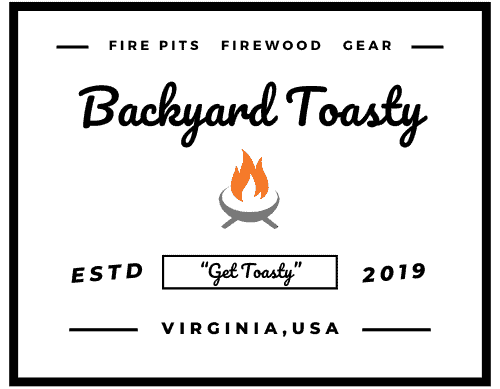
By J. Herwick
We use affiliate links and may receive a small commission on purchases.
Read more about us.
If you’ve wondered about the technology behind smokeless fire pits and how it makes a smokeless fire pit smokeless then you are in the right place.
We’ll cover all of that and more and by the time we’re done hopefully, you’ll be a lot more informed on the topic, especially if you are in the market for a new fire pit. Let’s go.
Generally speaking, a smokeless fire pit is a fire pit that draws in air through multiple inlet holes at its exterior base, channeling that air to the base of the fire and to the inner opening of the fire pit. This directed air helps the fire burn more efficiently at the base of the fire and burns off smoke at the top of the fire pit.
This design used in smokeless fire pits these days is not a new one. The “technology” was originally developed to build small efficient burning wood stoves for use in the developing world.
The jump of this design to smokeless fire pits is not surprising as it solves one of the primary, if not the primary, complaints users have with wood-burning fire pits which is excessive smoke.
I’ll get more into that below as we move along.

What is a Smokeless Fire?
First, let’s clear up one pretty important presumption many new smokeless fire pit owners make. The presumption is that their fire pit shouldn’t have any smoke at all.
Smokeless does not mean smoke-free. The term smokeless means less smoke.
Manufacturers of smokeless fire pits can’t legally make the claim that their fire pits are smoke-free because it’s not possible to have no smoke at all in a wood-burning fire pit. Minimal smoke is what they’re going for.
I’ve seen new Solo Stove owners stuff their fire pit to the brim with unseasoned wood and/or high-smoke firewood types, light it up, and watch it smoke like a chimney.
At this point, many figure they’ve been sold a bill of goods. In addition to not following their fire pit’s directions, they believe there is some sort of magic that will kick in, eliminating the possibility of any smoke appearing after ignition.
The bottom line here is, all fires made with wood will have some smoke, including a smokeless fire pit.
The difference is, a smokeless fire pit uses focused air in multiple places to burn hotter and cleaner, keeping the amount of smoke to a minimum.
With the right wood, in the right amount, getting to a smokeless fire pit to work the way it was designed to isn’t that hard. More on that later.
Let’s talk about how smokeless fire pits work.
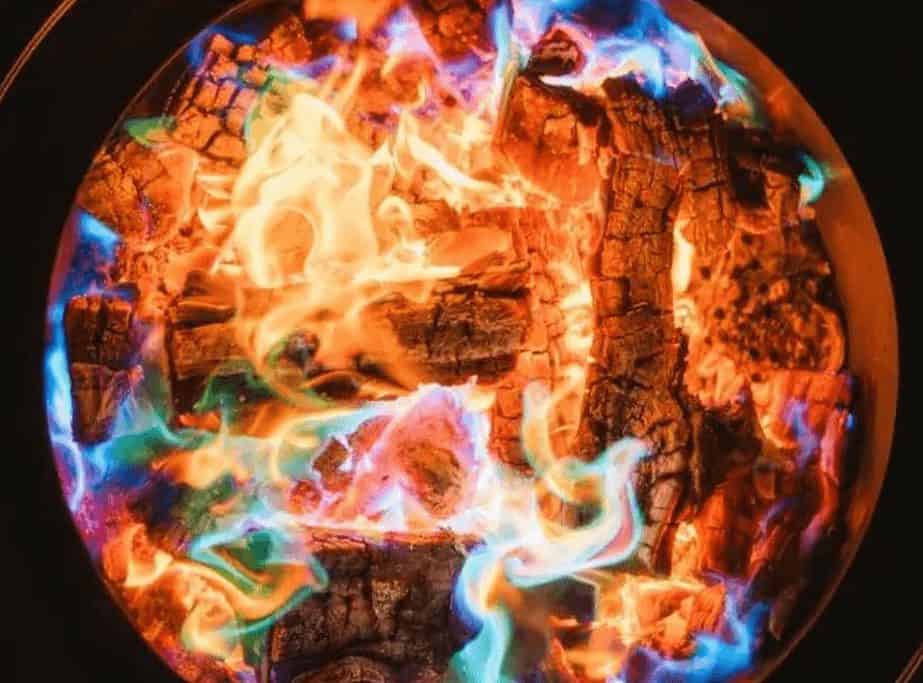
How Do Smokeless Fire Pits Work?
To understand better how smokeless fire pits work let’s talk about typical non-smokeless fire pits that use firewood for fuel, how they work, and the features that make a smokeless fire pit different.
Smokeless Fire Pit vs. Regular
The design of traditional fire pits is pretty basic; it’s usually some sort of bowl or cylinder where wood is stacked, lit, and burned.
This design contains the fire, keeping it off the ground and away from things you don’t want to be damaged.
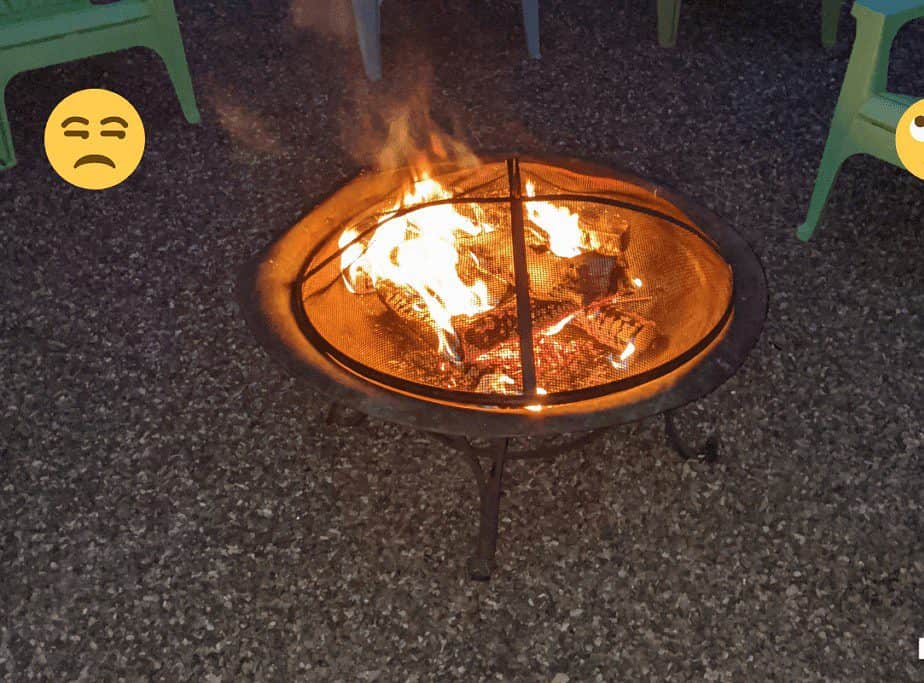
The fire pit is fueled by the wood you feed it and from the air around the fire on all sides, except underneath.
What makes smokeless fire pits work better vs. regular wood-burning fire pits is how and when they use available air (oxygen).
The science behind smokeless fire pits isn’t that complex but the effects are very noticeable when compared to those of normal open fire pits/fire bowls.
What creates those effects, a hotter more-efficient burning fire, and less smoke, is done by making sure air gets to the places in the fire pit where it will do the most good.
Let’s talk about what moves that air and the places where it counts in each stage of producing a smokeless fire.
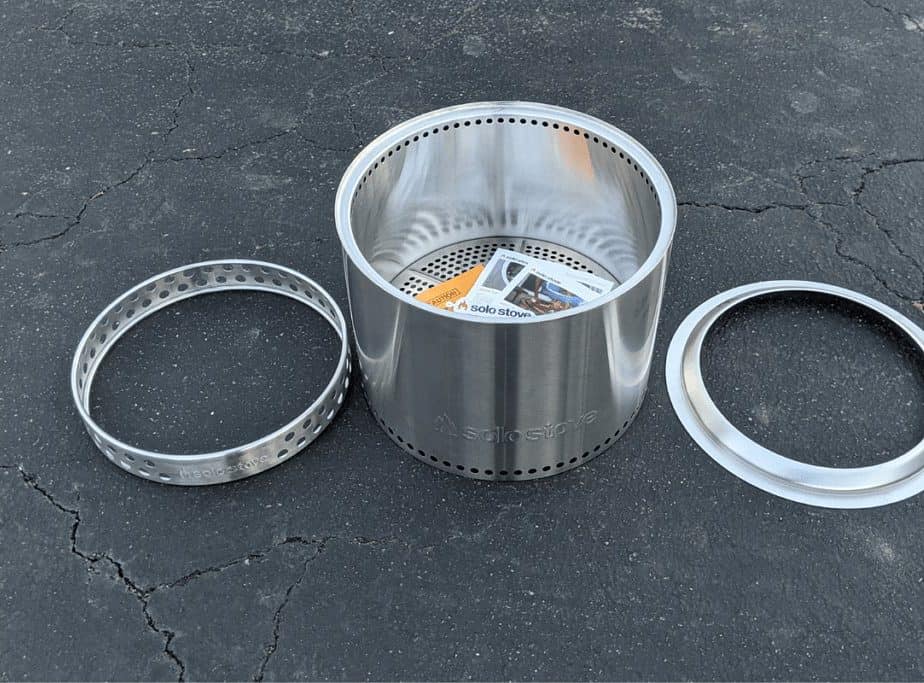
What Makes a Fire Pit Smokeless?
There are basically three key components of smokeless fire pit design that contribute to them being smokeless.
Air holes at the base, a double wall to heat and move air, and air holes at the top working together are what make a smokeless fire pit smokeless.
We’ll start at the place where the smokeless process starts.
Air Inlet Holes at the Base
One of the key features typical in smokeless fire pits is two sets of holes; one set on the exterior near the bottom and another on the interior near the top.
I’ll cover exterior holes first because they have a big role in the initial stages of the smokeless process.
Once a fire is lit and the fire burns for a moment, the air is pulled into the exterior holes at the base when a vacuum is created by rising gasses inside the fire pit.
The air that travels through these inlet holes is now directed in two directions.
Some airflow is vectored to the base of the fire from underneath, aiding the combustion process immensely.
The rest of the airflow travels upward through a double wall until it exits through a set of interior vent holes toward the top of the fire pit. More on double-wall construction in the next section.
This is one of the primary advantages of smokeless fire pits when compared to traditional wood-burning fire pits.
Regular fire pits pull air in but it’s not focused on where it’s needed most and definitely not from underneath.
Double Wall Construction
A critical component of smokeless fire pit construction and a key part of what makes a smokeless fire pit smokeless is the use of two walls, an interior wall, and an interior wall.
This double-walled construction provides a space to contain, move, and heat air traveling from the exterior vent holes near the bottom to the interior vent holes at the top of the fire pit (see diagram above).
This airflow up the fire pit’s double wall makes the secondary combustion at the top of the fire pit possible.
It’s this secondary combustion that reduces the amount of smoke before it leaves the fire pit.
Interior Vent Holes at the Top
Before the secondary burn takes place, hot airflow through the fire pit’s double wall exits through a series of holes at the inside top, near the rim.
Once this hot air travels through those holes and is dumped right at the top of the fire, it then aids in fueling the burn of smoke escaping from the fire pit.
That’s basically the long and short of how smokeless fire pits work. Now let’s talk about what should look like when it all comes together. Good secondary burn is a key indicator that things are going right – see below.
What Does Secondary Burn Look Like?
Take a look at the video immediately below – this is textbook secondary burn.
This is the previous Solo Stove Yukon model (previously 30 in. in diameter, now sold only 27 in.)
I’ve got a good fire established, there’s good airflow and smoke is being burned off as about efficiently as this fire pit can.
The air coming from the top inner holes near the rim is feeding a 360° secondary burn which is what you want to maximize what the fire pit is capable of.
The combination of superior airflow at the base of the fire and that secondary burn at the top is what makes a fire pit smokeless.
A fire that burns efficiently (and hot) depends on air being able to move freely at the base of the fire and through pockets between the firewood, kindling, etc. Smokeless fire pits as a rule provide that boost in airflow to the underside of the fire.
Each feature I covered above is an integral part of every smokeless fire
Are Smokeless Fire Pits Really Smokeless?
Everything we’ve covered by now sounds great, right? That said, when shelling out a few hundred bucks for a new fire pit, consumers want to know if what they are buying is the real deal.
In this case, they want to know if this smokeless thing is legitimate – in other words, are smokeless fire pits really smokeless?
The answer to that question, using the definition of smokeless discussed earlier, is yes (meaning less fire pit smoke). However, it is not just a matter of throwing wood into a smokeless fire pit and wishing for the best.
There are certain “rules” you need to follow to make a smokeless fire pit truly smokeless.
Even the best smokeless fire pit will smoke like crazy if you don’t get these right. They are:
Don’t Stack Firewood in a Smokeless Fire Pit Above the Interior Vent Holes
The secondary burning of smoke leaving the fire pit will be greatly reduced if firewood is stacked at a height higher than a smokeless fire pit’s interior vent holes.

Pro Tip: keep the top of the firewood stack below the interior vent holes | Image Credit: Backyard Toasty
That double burn you want takes place at the same level as these holes. Any smoke from wood burning above these holes will escape without being burned off.
Use Well Seasoned (i.e. dry) Firewood to Fuel the Fire
Unseasoned (or damp/wet) firewood smokes heavily when burned. This excess smoke is due to the inefficiency of the burn due to excess moisture. The ideal moisture content for firewood is 20% or less, but 30% or less will work.
You can get away with slightly less seasoned firewood (30 to 40% moisture content) if you make sure to follow the rule about having a hot coalbed below.
Steer Clear of Coniferous Tree Firewood Types
Coniferous trees (softwoods like pines, firs, cypress, spruce, cedar, etc.) all contain pitch at different levels which is going to make them smoke more so than hardwoods like oak, maple, ash, etc.
That pitch may also gum up critical airflow throughout the fire pit if used regularly.
Kindling and tinder from coniferous trees are fine when used in starting the fire pit but I’d avoid using wood from these tree species as the main firewood source. Even when well seasoned you will still get much more smoke than with hardwoods.
Build a Very Hot Coalbed Before Adding Main Firewood
This rule is the number one piece of advice I’d give any new user of a smokeless fire pit.
Smokeless fire pits can be much more forgiving than other types of wood-burning fire pits due to the benefits of their design.
When operated properly smokeless fire pits tend to burn hotter, and as a result, cleaner (meaning less smoke).
When I say operated properly I mean starting with a super hot coal bed before adding the main source of firewood.
A solid coalbed will maximize the benefits of a smokeless fire pit and ensure a high performing low smoke fire that won’t go out until you want it to.
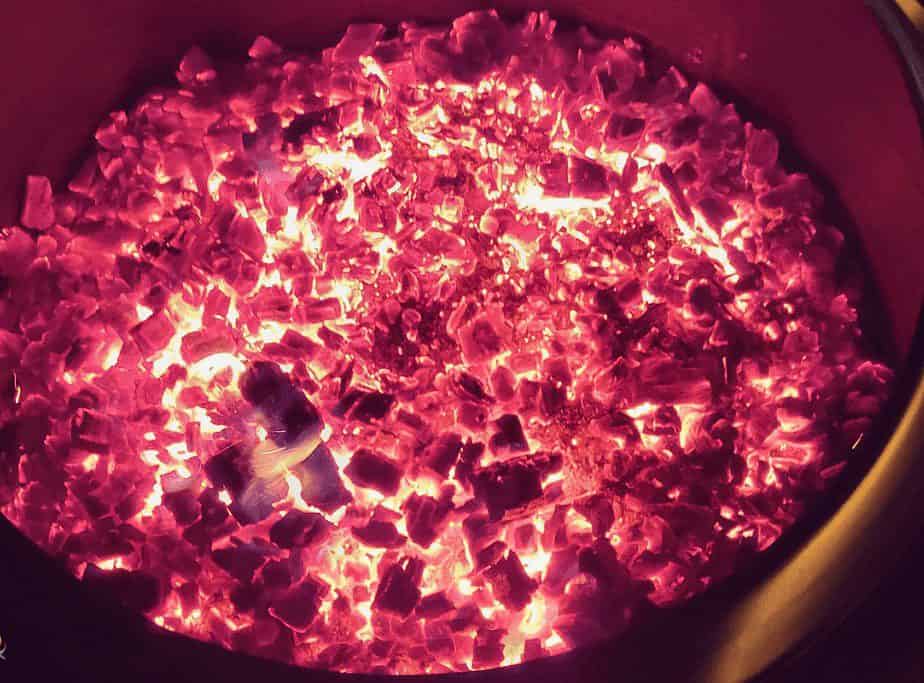
How to Build a Hot Coal Bed in a Smokeless Fire Pit
This is how I build a blazing coal bed in a smokeless fire pit before I add the large pieces of firewood.
- Start with a simple teepee stack of good dry hardwood kindling in the base of the fire pit; pine fatwood works well in step too
- Position a few lightly packed balls of newspaper, or a commercially available firestarter around the base of the stacked kindling
- Light the paper or firestarter at the base of the kindling stack
- As the paper begins to burn, begin adding the driest twig sections you can find to the areas of the stack that are burning; twigs should be about the diameter of a drinking straw or narrower; these pieces catch quickly but burn up just as fast so have plenty on hand
- As the fire starts to get going add one or two smaller firewood splits to the fire to get them going; these pieces of wood are what will turn into your coal bed
- Continue to add similar-sized pieces until the bottom of your fire pit is covered with red-hot coals
- Once the coal bed has been established you can then begin adding larger firewood splits and rounds to the fire; continue to add firewood as needed at this point to keep the fire going
A hot coal bed will pull any moisture present in the firewood you use right away, helping it catch faster, burn longer and more efficiently, and with less smoke.
Whatever technique you use, make sure to take your time upfront and establish a fire that will light the first time, stay lit and efficiently burn whatever you put in it.

The Scientific History Behind Smokeless Fire Pits
The science of smokeless fire pit technology, as I mentioned before, goes back a few years and was not originally for recreational use.
The work done in developing the technology was more humanitarian in nature.
The idea was to create an inexpensive, super-efficient stove to cook over and/or create biochar, with little smoke, that could be used to improve the lives of people in the developing world.
Two independent efforts by Dr. Thomas Reed and architect Paal Wendelbo developed TLUD concepts in the early to mid-1990s initially for use in Africa.
What came out of that initial effort became known as a T.L.U.D., or Top Draft Uplit Gasification stove. < – – – the link is to an example of the TLUD stove developed by Dr. Reed at Engineering for Change, an international organization that promotes engagement within the engineering community to improve the quality of life for people around the world.
Wood gasification was not new at the time, having been used in industry for years, but scaling it down to a size useful for those in the developing world hadn’t been tried up to that point.
Since this time, others have taken the idea and improved upon it, attempting to increase biochar yield, adding forced air to enhance performance, creating smaller models, etc.
In Closing: What is a smokeless fire pit?
Today’s smokeless fire pits are a big improvement in design, aesthetics, and performance over the typical wood-burning fire pit most of us are used to.
Most importantly, less fire pit smoke is not only less annoying, but it’s also a lot friendlier on the lungs.
By following a few simple rules, you can dramatically reduce the amount of smoke produced by your fire pit.
I’ve listed some additional tips and featured products below that should help get you started.
Enjoy your time around the fire!
Thanks for reading.
Smokeless Fire Pit FAQs:
1. Are smokeless fire pits better for the environment?
One of the original goals behind the original biochar stove/TLUD technology (currently used in smokeless fire pits today) was to create a healthier and more efficient cooking stove for those throughout the world who still prepare most of their food over an open fire.
Straw, animal waste, coal, and other similar open-fire fuel sources have been ID’d as high in pollutants and are a key driver of respiratory illness in certain parts of the world because the smoke they produce is so dirty.
Biochar stoves were designed and built in part to solve this problem by reducing the amount of smoke emitted.
According to the International Biochar Initiative, biochar stoves (the precursor of smokeless fire pit technology – my words) are considered, “potentially much cleaner, with lower emissions of carbon monoxide, hydrocarbons, and fine particles” and “have lower greenhouse gas (carbon dioxide and methane) and black carbon emissions, create biochar that can be used to sequester carbon in soils, and reduce the use of fossil-fuel based fertilizers.”
The jury is still out on how much better smokeless fire pits are in reducing pollution in comparison to their traditional fire pit counterparts.
But, used in the right way, with the right fuel (dry hardwoods), you will get less smoke, which seems like a positive step in the right direction.
2. Do smokeless fire pits smell?
No, smokeless fire pits don’t smell any different than other wood-burning fire pits when in use.
What smell you do get should be much more subtle due to the smaller amount of smoke emitted.
3. Do smokeless fire pits give off heat?
Yes, smokeless fire pit fires get very hot (~900-1200 degrees F) due to enhanced combustion efficiency.
That said though you may have to sit a little closer due to the cylindrical design common in smokeless fire pits. How close may depend on the size of the smokeless fire pit you are using, how big of a fire you build, etc.
The heat tends to go straight up, instead of out and up like a conventional fire pit.
I’ve seen a lot of homemade remedies for this that often involve a disc of some sort (a metal pizza pan or other circular sheet metal product with a set of legs bolted or welded on to hold it up), that’s placed over the fire pit to direct heat outward toward those seated around it.
Solo Stove is the only smokeless fire pit maker I’m aware of that mass produces a heat deflector similar in purpose to the homemade ones mentioned.

There have been square heat deflectors with four legs on the market for a while but those aren’t likely to work on a round fire pit needing an exact fit.
